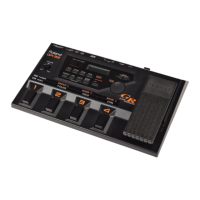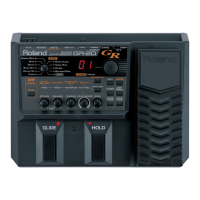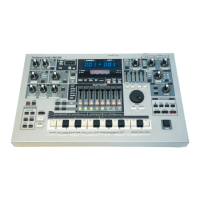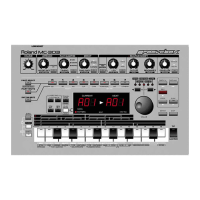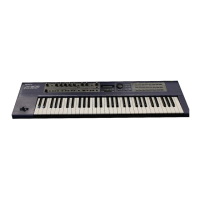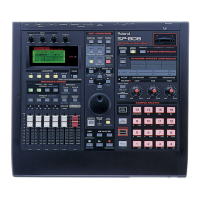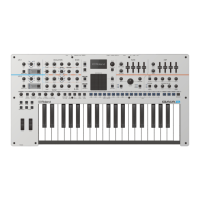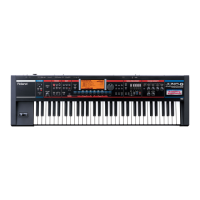In the Play mode, you can get different effects by
pressing each of the pedals 1 to 4 in the follow way.
Let’s actually go into Pedal Effect mode by pressing
the [S2] button on the GK-2A, and try these effects on
various patches using the pedal. The particulars of
each effect will vary with each patch you change to.
➼
In the Play mode, even if the PARAMETER SELECT
dial is set to PATCH INC/DEC BY S1/S2 when you
press a pedal, you will still be able to get the same effects.
Getting a Pedal Wah Effect
(Wah)
You can get several of the most typical wah effects by
pressing pedal 1 (WAH). Repeatedly pressing and
releasing the pedal produces changes in the sound
resembling those of a guitar wah-wah pedal, and
these effects can then be added to synthesizer sounds.
You can choose from a number of variations already
prepared using different combinations of rate of
sound change, degree of change, panning, how pecu-
liar the sound is, and so on; these can then be saved to
each patch.
Also, when you select modulation (shown in the dis-
play as “Mod”) in the patch settings (p. 45), then
instead of wah-type effects, you will hear a deep
vibrato (undulating or wavering pitch) when the
pedal is pressed. With this effect, since you can
achieve the machine-type vibrato that so resembles
that typically “synth-ish” sound as well as the more
human-feeling swaying effect you get when using fin-
ger vibrato, you can decide which one to use. (For
more information about these effects and how to use
them, see p. 45.)
➼
It may happen that if you press pedal 1 (WAH) once
when other pedals are not being pressed, the sound is
different than when the patch was selected. (The sound
may be muffled, or have a strange quality to it.)
Return to the original patch, switch to a different patch
and then recall the original patch again. If the bank shift
pedal is connected, then while in Pedal Effect mode, you
can return to the original patch by pressing the bank
down pedal.
The application of wah-type effects varies with the select-
ed tone.
Changing Pitch Dynamically
(Pitch Glide)
Press pedal 2 (P-GLIDE) to get a pitch glide effect.
This effect creates continuous changes in pitch over
variable time intervals, long or short.
With chords, since you can make big changes in pitch
while maintaining each of the intervals of the chord, it
differs from a guitar’s vibrato arm/vibrato
bar/whammy bar, and provides a unique effect.
As for the time duration and glide intervals, you can
select from nine prepared pitch rise and fall patterns,
and then save them to patches (p. 46).
✽
Depending on the selected tone, the tone settings, and
performance conditions, the width of the effect may be
limited.
Holding a Synth Tone After
the String is Stopped (Hold)
Press pedal 3 (HOLD) to get the hold effect. When
you use this effect, the synthesizer sound continues to
play even after the guitar string has stopped vibrat-
ing.
You can choose from a number of variations to suit
whatever you have in mind — hold the synthesizer
chord while the guitar plays melody, hold only one of
two layered tones, hold only strings 5 and 6, and
more — and then save them to patches (p. 47).
✽
While the Arpeggiator is on (the red light of the
ARP/HAR five-light indicator will be on), the way Hold
behaves and the variations that can be selected will be
different than normal (p. 53).
●●●●●●●●●●●●●●●●●●●●●●●●●●●●●●●●●●●●●●●●●●●●●●●●●●●●●●●●●●●●●●●●●●●●●●●●●●●●●●●●●●●●●●●●●●●●●●●●●●●●
<Display Details>
When pedal 1 (WAH) is pressed
“UAH” or “Mod” appears in the display
When pedal 2 (P-GLIDE) is pressed
“P.GL” appears in the display
When pedal 3 (HOLD) is pressed
“HLd” appears in the display
Additionally, all the lights of the five-light indicator
will flash to indicate a pedal effect is in operation.
●●●●●●●●●●●●●●●●●●●●●●●●●●●●●●●●●●●●●●●●●●●●●●●●●●●●●●●●●●●●●●●●●●●●●●●●●●●●●●●●●●●●●●●●●●●●●●●●●●●●
24
Changing Sounds with the Pedals

